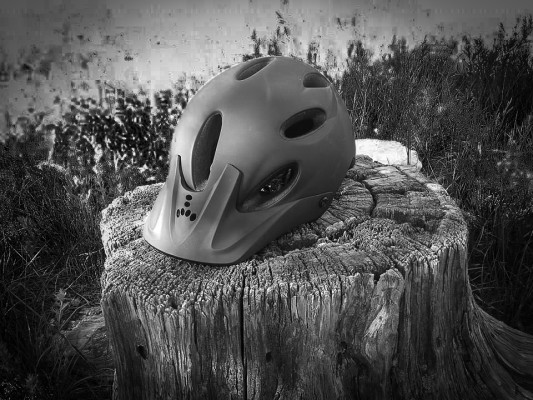The Compass helmet, made by NYC-based Triple Eight, is designed to be a multi-purpose helmet for mountain bikers as well as commuters, with a design nods towards the slopestyle lids of many talented riders.

Out of the Box
Though this speaks nothing to the functionality of the helmet, the helmet came packaged in a satin black box and was neatly and cleanly placed, unlike a lot of the traditional open-face boxes that allow the helmet to gather dust in storefronts and potentially suffer damage from transit or patrons. This was a nice little touch that underscored a level of care and quality not seen across the board in mtb helmets.
I received a matte black Compass, and I was impressed with the feel and look of the helmet finish–something akin to a Teflon skillet–which instantly made me wonder if this helmet was designed to slip across the earth in a crash, instead of getting caught up on multiple “ridges” that so many other helmets have… again, not unlike a park helmet. Those “ridges” are often the product of extensive venting that manufactures use to keep air flowing. In contrast, this helmet had very few vents, only 9 in fact, which differs greatly from manufacturers that place 15-20 vents to maximize airflow. Would this be a problem? “We shall see,” I thought. 
Fit
At a solid 57cm, my noodle squarely fell into the S/M helmet range, designed for 55-59cm head sizes. The fit was comfortable, with a little room to spare, and enough to crank down on the the Adjustable Fit Dial system to get things nice and snug. There wasn’t any appreciable movement when moving my head left to right or fore and aft, a personal mark of a good fit in the event of a crash (having your helmet move on top of your head even after the dial is seated securely is not only annoying but dangerous in more violent crashes). The visor was adjustable about 1-2 cm, and felt well-placed and allowed good forward vision even when lowered all the way.

The Deets (from Triple Eight)
With a lightweight in-mold design, the Compass is perfect whether you’re heading out of town to hit your favorite mountain trails or dodging traffic and potholes in the bike lane. The Compass features greater head coverage than traditional bike helmets and an Adjustable Fit Dial System to provide a secure, custom fit, no matter how rugged the terrain.

• Complies with U.S. CPSC Bike safety standards
• Lightweight and durable in-mold construction
• Complete with our renowned Sweatsaver Fit Pads for added comfort
• Adjustable Fit Dial System to create a custom fit
• Grooved EPS for phenomenal air flow
Size Chart
S/M 21.75–23.25 in (55–59cm)
L/XL 23.25-24.75 in (59-63cm)
MSRP $74.99

Construction
In case you’re not up on your helmet materials nomenclature, in-mold helmets (soft shell) differ from hard shell (think: skateboarding) helmets in that they have a thin polycarbonate shell that is molded together with an EPS liner. Hard shells resist penetrations, but can cause brain injuries because they lack any compliance to absorb an impact. In-mold designs abosrb destructive impact energy well, often allowing the helmet to crack and disintegrate, much like the crumple zones in modern cars. This, in turn, transfers less stress forces to the head and brain, and often less rotational forces, which can cause neck injuries. The disadvantage of in-mold helmets is that they are usually worthless after a hard crash–but that’s ok if it saves your brain!
Testing
Trails in the Rockies demand a solid helmet in the event of a hard crash. I elected to try the Compass out on my local singletrack in the front range of Colorado, in addition to the fast flowy trails in Crested Butte, unforgiving rocky alpine trails in Salida, the hot summer desert in Fruita, and in bike parks. This helmet was tested in summer with temps ranging from 70s-90s, which I consider appropriate given my curiosity about adequate ventilation.
What I found was that even on the hottest days, I actually preferred to have this helmet on, not off, for long climbs on exposed fire roads. The ventilation and shade it provided was better than the sun beating down on my head directly… which convinced me that the ventilation was solid. Only when the temps were in the 90s, and I was in the sun, did I feel warm… but wearing any black helmet in the sun is likely to do that. Nevertheless, I kept it on. Although I took a few diggers and even an endo or two wearing this helmet, I never hit my head and, thankfully, cannot attest to the crash effectiveness. I will trust that CPSC testing did that heavy lifting for me and you, without the precious cargo inside.

Bottom Line
No doubt about it, this is a great helmet. Triple Eight is not as well known in the mountain biking world as some other manufacturers, but the Compass is a strong inaugural entry into the market and it comes from a pedigree of quality helmets that span many other disciplines. I had no reservations about wearing it when choosing gnarlier lines and working my bike up to speed. It stayed put and I forgot I that I was wearing it–which is what a comfortable helmet should be like. After some serious abuse over the past few weeks, I feel that this helmet is designed to last. At less than $75, you’ll be hard pressed to find a more solid, comfortable, stylish helmet for the money.

Thanks to Triple Eight for sending the Compass over for review!





















0 Comments